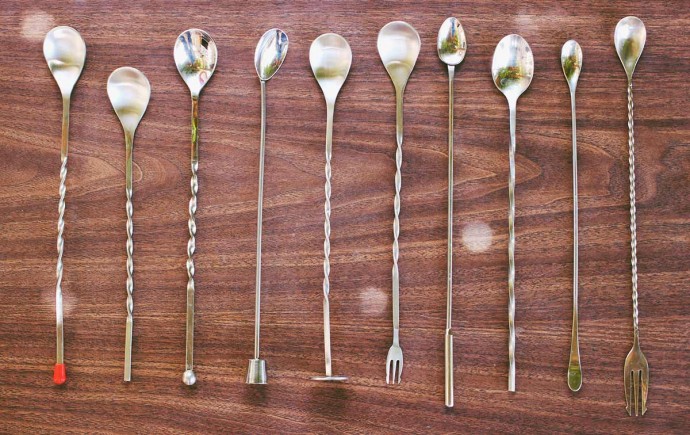Last week, we went over the basics of choosing a proper mixing glass (or, if you’re like us most of the time, improvising one from the stuff you have lying around your kitchen), and this week we’re moving on to its partner in crime: the barspoon.
Why do I need a barspoon?
First, let’s talk a little bit about stirring cocktails in general. The end goal isn’t just to mix the ingredients together, it’s to chill the drink and allow a little bit of ice to melt and dilute it a bit. This helps to soften up the spirits without watering them down as much as shaking would.
The key to chilling a cocktail properly is to forget everything you know about culinary stirring. Rather than agitating through the middle of the mixing glass like you’re mixing a stew, you want to rotate your spoon around the inside of the glass in a smooth, circular motion. The individual ice cubes shouldn’t move too much, but they should move together as a single, rotating cylinder.
Unfortunately, this can be difficult to do with a regular spoon. Most teaspoon handles are too short to reach all the way to the bottom of a mixing glass, and the head of a soup spoon is usually too large to properly seat between the ice and the inside of the glass.
There are a few things that make a barspoon perfect for mixing cocktails. First, the handle is long and thin, meaning that there’s plenty sticking out of the glass for you to work with. The handle is also twisted into a smooth, spiral coil that allows it to rotate freely in your hand as it makes its way around the glass. Finally, the actual head of the spoon is only curved very slightly, which lets it fit perfectly into the small gap along the outer edge of the ice.
Which barspoon do I get?
A good barspoon is one of the things you’ll want to spend a few bucks on when building your collection. And when we say a few, we mean a few. You can find fancy ones for $30 and up, but a sturdy stainless steel spoon (say that three times fast) shouldn’t run you more than $10. Here are some of our favorites:
Hiware 12-Inch Stainless Steel Mixing Spoon ($7) – For the budget-conscious, this one is a great choice. It’s sturdy, it gets the job done as well as any of its competitors, and you can pick one up for only seven bucks on Amazon. Plus, it looks a lot nicer than those cheap ones with the red plastic caps on the end. What’s not to love?
Stainless Steel 30cm Teardrop Barspoon ($23) – The barspoons on Cocktail Kingdom are a good deal pricier than the ones you’ll find elsewhere, but they’re also very well-made. You’ll notice that the coils are tighter and smoother, which allows the spoon to rotate more easily in your hand.
Copper-Plated 50cm Trident Barspoon ($37) – If you really feel like splurging, this spoon is a beaut. You’ll notice the same coiling as the last one, but it’s also 20cm (about 8in) longer, which lets you do some seriously stylish mixing. The end sports a small fork that’s great for spearing garnishes or fighting off overeager patrons, and the copper plating looks gorgeous. But be forewarned, if you’re anything like us you’ll be committing a matching set of copper everything down the line.
What if I’m broke and can’t afford a barspoon?
While those fancy barspoons are nice to look at, the reality is that you won’t always have one handy. In a pinch, any long-handled spoon you have lying around (or tucked into the back of that drawer you never open) should do the trick, as long as it doesn’t have too large of a head. Try to find one that’s thin enough to move in your grip with relative ease, and you can avoid most issues by simply not holding on to it too tight while you’re stirring. Surprisingly, we’ve also found that a single chopstick works decently well, but don’t tell our friends in the industry we said that.
When you get right down to it, though, this might be one tool that’s worth a little investment.
Photo: Simple Cocktails



